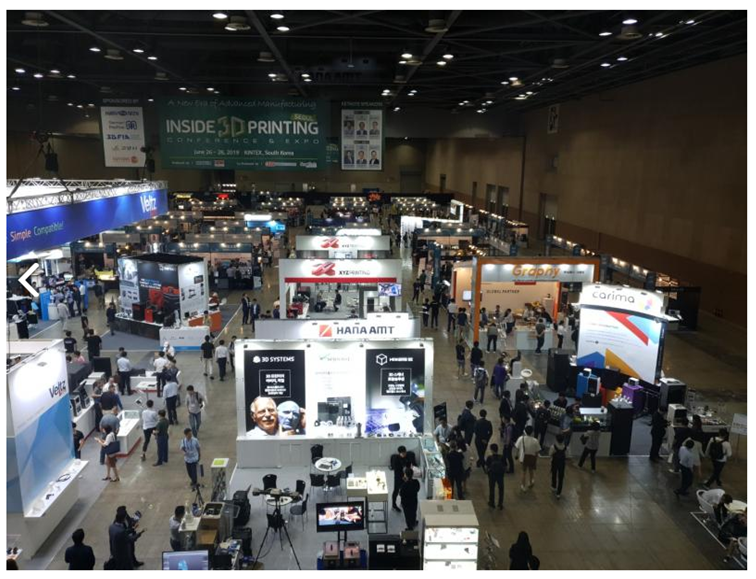![3D Printing convention in Seoul [Source: Inside 3D Printing Seoul ]](https://fabbaloo.com/wp-content/uploads/2020/05/SouthKorea1_img_5eb093bb300fe.png)
Cameron Torti and Charles Goulding of R&D Tax Savers discuss 3D printing and supply chain considerations in South Korea.
On Display
Inside 3D Printing, one of Asia’s largest 3D printing events, took place in Seoul, South Korea June 26-28 this year. The event anticipated more than 12,000 attendees from 28 countries demonstrating how prominent South Korea has become in the additive manufacturing industry. Exhibitors are given the opportunity to present their products to a global audience and to absorb some of the growing market in Korea. With China Trade war challenges, U.S. companies may want to evaluate South Korea as a supply chain alternative.
Supply Chain Alternative
Tech firms have utilized supply chains from China for decades now. Assembling more than half of all mobile phones, almost all printed circuit boards and 20% of all semiconductors, China is surely the superb chain dealer. However, with trade war costs and uncertainties along with a rise in labor costs, firms are now turning to other nations such as South Korea for their supply chain needs. SK Hynix of South Korea has started to move production back to their home country.
Korean Innovation
In recent years South Korea has been at the forefront of the 3D printing industry, pushing numerous advancements.
![3D printed cornea [Source: Asian Scientist ]](https://fabbaloo.com/wp-content/uploads/2020/05/SouthKorea2_img_5eb093bbaf3db.png)
A 2019 study published by Biofabrication, a South Korean research group developed a method for printing artificial corneas. Per year, approximately 185,000 corneal transplants are conducted and an estimated 12.7 million people are waiting for a corneal transplant. With a shortage in the number of donors as well as finding matches that won’t be rejected by the immune system of the recipient, 3D printed corneas are a remarkable medical achievement. Although the wait time for a cornea donation can be upwards of six years, existing artificial corneas do not integrate well with the eye. The 3D printed cornea uses a bio-ink comprised of corneal stroma (fibrous collagen) and stem cells. These materials make it biocompatible, causing no immune reaction.
The military in South Korea can now replace tank parts in a matter of days or even hours. Before this technology was available, wait times for parts could well over 100 days even for a part worth less than $5. The only drawback is that metal parts can’t be printed so their replacements are only temporary. Still, this keeps vehicles operational until new parts come. Also, an increasing amount of work is being put into making 3D printed metal feasible.
![Food 3D printing process [Source: Jin-Kyu Rhee, Ewha Womans University ]](https://fabbaloo.com/wp-content/uploads/2020/05/3DPfood_img_5eb093bc19049.jpg)
A new approach to nutrition is being developed using 3D printing technology. Researchers in South Korea are developing customized food items using powder ingredients. The structures of these foods can be controlled at the nano-level, enabling them to mimic the look and texture of normal food. The 3D printing platform that the team has built allows customized microstructures so that food absorption and textured can be personalized. The machine prints very similarly to others but the food material is first crushed at close to -100 degrees Celsius. On-demand food production would eliminate waste and help solve the global food crisis fueled by overproduction and over population. It may also serve as a tool for meeting the nutritional needs of those in developing nations.
U.S. Companies engaging in 3D printing activities are eligible for The Research & Development Tax Credit.
The Research & Development Tax Credit
Enacted in 1981, the now permanent Federal Research and Development (R&D) Tax Credit allows a credit that typically ranges from 4%-7% of eligible spending for new and improved products and processes. Qualified research must meet the following four criteria:
-
Must be technological in nature
-
Must be a component of the taxpayer’s business
-
Must represent R&D in the experimental sense and generally includes all such costs related to the development or improvement of a product or process
-
Must eliminate uncertainty through a process of experimentation that considers one or more alternatives
Eligible costs include U.S. employee wages, cost of supplies consumed in the R&D process, cost of pre-production testing, U.S. contract research expenses, and certain costs associated with developing a patent.
On December 18, 2015, President Obama signed the PATH Act, making the R&D Tax Credit permanent. Beginning in 2016, the R&D credit can be used to offset Alternative Minimum Tax for companies with revenue below $50MM and for the first time, pre-profitable and pre-revenue startup businesses can obtain up to $250,000 per year in payroll tax cash rebates.
Conclusion
Undoubtedly South Korea is a major player in the 3D printing world. They aren’t just using 3D printing; they are at the cutting edge of innovation. Their advancements span across several industries including medical, defense, and food.











